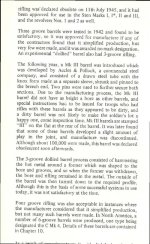I tried previously to get some input on the nature of WW2 Enfield barrels described as having 'dollied' rifling, but I didn't use the term in the title of the posting - I'm hoping that re-posting my query with the subject made clear will attract someone who can explain by what process such barrels were actually made.
The term came up in a book about the WW2 #4 rifles - the various barrel types were described, and one, evidently an (unsuccessful) wartime expedient, was described as having been made from steel tubing, with the breech reinforce (nock's form) shrunk and pinned to the barrel. The barrels were described as having rifling 'dollied' into the tube, and were also said to have a 'dull' appearance to the rifling, as opposed to conventionally-rifled #4 barrels, though it wasn't clear whether the shape of the lands and grooves or the surface finish in the bore was thought to be 'dull'.
I've inquired at various fora, but have thusfar received only speculation about what process was referred to as 'dollying' in barrel making - the likely candidates are hammer-forging and buttoning, but I'd really like an authoritative reference, if available, since I've never encountered the term in reference to barrel making anywhere else.
Can anyone clarify the matter?
Thanks;
mhb - Mike
The term came up in a book about the WW2 #4 rifles - the various barrel types were described, and one, evidently an (unsuccessful) wartime expedient, was described as having been made from steel tubing, with the breech reinforce (nock's form) shrunk and pinned to the barrel. The barrels were described as having rifling 'dollied' into the tube, and were also said to have a 'dull' appearance to the rifling, as opposed to conventionally-rifled #4 barrels, though it wasn't clear whether the shape of the lands and grooves or the surface finish in the bore was thought to be 'dull'.
I've inquired at various fora, but have thusfar received only speculation about what process was referred to as 'dollying' in barrel making - the likely candidates are hammer-forging and buttoning, but I'd really like an authoritative reference, if available, since I've never encountered the term in reference to barrel making anywhere else.
Can anyone clarify the matter?
Thanks;
mhb - Mike


